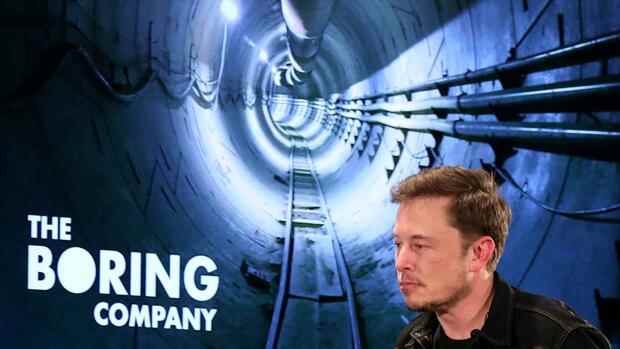Munich, Düsseldorf Adrian Fleck looks tired. Together with his team from the Baden-Wuerttemberg Cooperative State University (DHBW), Fleck is assembling a 1.1-ton drill in the scorching heat of Las Vegas.
It gets up to 42 degrees during the day. The eleven students, three professors and assistants put wet rags on their necks and drink five liters of water a day. “A lot of stress,” says the 23-year-old initiator and head of the project team over a video call.
And time is running out: everything has to be finished by Sunday. Then the “Not-a-Boring Competition” from Boring, Elon Musk’s tunneling company, begins in the middle of Las Vegas. It is the finale of the competition announced a year ago to find the fastest and most precise tunnel boring machine for Musk’s underground traffic concepts: Loop and Hyperloop. The name is a play on words – in English “boring” means both “boring” and “drilling”.
The task of the competition is to drill a 30 meter long and half a meter wide tunnel as quickly and as precisely as possible. The participants should be faster than a snail: “Can you beat the snail?”. What sounds funny isn’t an easy task. The spotted garden snail manages three meters in one hour – and is therefore a record holder.
Top jobs of the day
Find the best jobs now and
be notified by email.
The Hyperloop will one day transport people at 1200 kilometers per hour like in a pneumatic tube system through an almost evacuated tube. Due to the partial vacuum, the transport capsules that circulate through the tubes are not slowed down by air resistance. Meanwhile, the loop model envisages tunnels in which autonomous cars should travel at high speed.
TU Munich is the favorite
In addition to the DHBW team, a 40-person team from the Technical University of Munich (TUM) is also at the start. Most of the eight competitors, however, come from the USA. But Fleck is self-confident: “I think that we will be on the podium,” he says.
However, the TUM team is considered a big favorite. She was the only team that was able to test her drill in practice. “We want to win,” project manager Kilian Schmid announced months ago in an interview with the Handelsblatt.
The TUM students had already won all four SpaceX Hyperloop Pod competitions. “The pressure of expectation is of course great,” said TUM President Thomas Hofmann.
For a year, the team from Baden-Württemberg worked almost around the clock on their “Dirt Torpedo”. The students have copied its basic principle from nature. The drill is surrounded by three layers of rubber that can be inflated with up to 15 millibars. The drill can move “dynamically” while at the same time protecting the tunnel wall. “Like a worm in the ground,” says Fleck.
In addition, the drill works completely electrically – there is no risk of hydraulic fluids leaking. The team also developed its own orientation system for the drill and a new type of concrete valve.
The structure of the Dirt Torpedo is also innovative: from the drill head to the motor, all four assemblies are based on a Lego construction system. If there is a problem in a unit, it is easier to replace.
On the other hand, Fleck is worried about the cooling. The DHBW team cools the drill head with nozzles that spray water. The students want to save water, because usually drills are protected from overheating with a lot of water. However, given the heat in Las Vegas, the undergraduate student has concerns.
Nevertheless, Gangolf Kohnen, professor of mechanical engineering at DHBW, considers the competition to be a unique opportunity: “Our students can test the limits of what is technically possible here,” he says.
Control with 30 sensors
According to the team, the design of the TUM tunnel boring machine that is now being used is based on a balanced mix between principles of the industry standard such as pipe jacking and several innovative approaches to solving inefficiencies and increasing the rate of advance.
For its first draft, the team was able to fall back on a small drill model that project manager Schmid had built in 2018 when he was just 20 years old. Cities can only get the traffic problem under control if they break new ground, says Schmid. He was already convinced of that back then.
The propulsion system consists of two clamps, each driven by four hydraulic cylinders. In continuous mode, the system has a propulsive force of up to 500 kilonewtons. The transport system consists of six conveyor belts integrated into the pipes used to build the tunnel structure. The controller receives signals from around 30 sensors. The control system uses a laser to measure whether there are any deviations from the planned tunnel axis. The drill is more than twelve meters long.
Companies as sponsors
The construction of the Munich drill was also made possible by support from industry. The partners include, for example, construction companies such as Bauer and Max Bögl, the tunnel specialist Herrenknecht and Thyssen-Krupp.
The DHBW team was also able to fall back on numerous sponsors such as Siemens, Herrenknecht and the pump specialist Putzmeister. “The support is just great,” says Professor Kohnen.
It remains to be seen whether the TUM team will win. But they have already achieved one thing: “Our drilling machine competes with a worm in terms of speed,” explains the team. “That is considerably faster than the industry standard.”
More: “Racing car of tunnel boring machines”: Munich students want to dig for Musk’s Hyperloop
.
